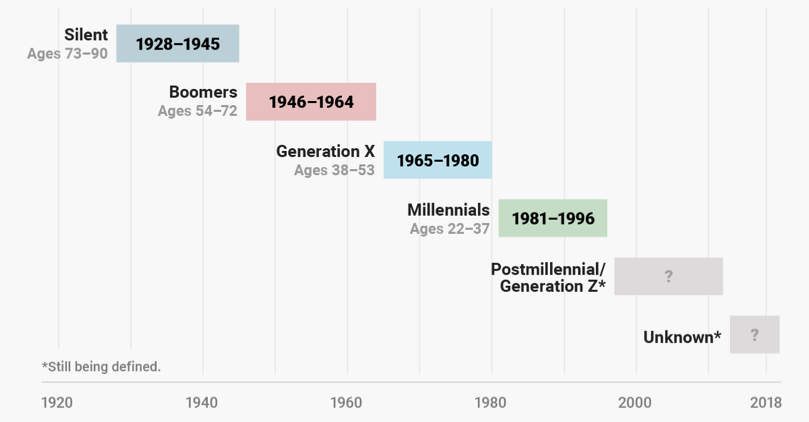Generation Games

We read headlines about Millennials and Generation Z (Gen Zs) daily, but many people are still not clear about the exact definitions of of these terms. Before shedding light on these groups, let’s take a brief glance at some generations prior to Millennials and Gen Zs, as well as an important related topic: why generational cohorts matter.
A Brief Glance at Previous Generations
Baby Boomers: People in this generational cohort were born after World War II. Per demographic studies, Boomers generally refused to follow traditional values and redefined them. Furthermore, they are considered to be the most active, fit, and wealthy generation as compared to the previous generations.
Generation X (Gen X): After Baby Boomers came Gen X. It was the time when there was a shift in societal values. Adult supervision, as compared to the previous generation, was reduced, and children born in this era were more self-dependent.
Why Do Generational Cohorts Matter?
In today’s world, generational cohorts matter, particularly in the advertising world. As a marketer or an advertiser, you simply cannot rely on a single message for a product or service to cater to an audience of every age group. This is the main issue that defining generational cohorts solves: segmenting audiences with similar values, ideas, lifestyles, and life experiences. This segmentation by generational cohort allows marketers and advertisers to create specialized messages for each age group.
Definition of Millennials and Gen Zs
Millennial: Generally categorized as those people who reached young adulthood by early 2020 and also referred to as Generation Y, it is commonly believed that Millenials cannot imagine life without gadgets, technology, and the internet. Social networking for them via digital means (i.e. using Facebook, Twitter, MySpace, etc.) is essential.
Gen Z: Gen Zs are post-Millennials. Born in a digitally revolutionized world, they are the most comfortable generation with technological advancements.

How AdInMo defines Gen Z and Millennial
There is not full agreement on the proper name for the post-Millennial generational cohort; however, Gen Z has become a common name for them. At AdInMo, we define Gen Z as people who are below the age of 19 (as of 2018), and Millenials as those from 19 to 35 years of age. Both of these generations are also known as “Digital Natives”, i.e. people who are born and brought up in the digital age. Hence, life without technology is unimaginable for them.
Why do Gen Zs and Millennials Matter?
Millennials and Gen Zs are important in today’s advertising and marketing frameworks. As they have different perception levels, satisfying them with traditional ads is a difficult feat, especially since nearly half of Millenials and Gen Zs don’t watch traditional TV. Unlike previous generations, they look for personal relevance in every ad they view and perceive it accordingly. This partially explains their low tolerance level to conventional ads. Since they form the major target audience for marketers in today’s world and the years to come, it is important to consider what these audiences want to view for effective marketing.
To learn how AdInMo can create authentic engagement experiences for your brands, email info@adinmo.com or visit us www.adinmo.com
More…
Meet us at Gamesforum Barcelona 2024
The 2024 event season is well underway with Spain being our next stop for Gamesforum Barcelona on 7th and 8th February. Come and meet us! All Gamesforum events feel like you’re hanging out with smart friends. You learn something and you enjoy their company. That’s why...
AdInMo hires industry big-hitter to smash 2024 in-game product innovation bringing Rewarded InGamePlay & Audio into the mix
Former TargetSpot and Azerion executive Adam Pattison joins Team AdInMo as Product Director to spearhead the company’s player-first roadmap. Great news for AdInMo; we've appointed industry leader, Adam Pattison, as its new Product Director. Adam joins from Targetspot...
Meet us at PG Connects London 2024
Meet Team AdInMo at PG Connects London on 22nd-23rd January 2024! We're super excited to be heading to The Brewery next week for Pocket Gamer Connects London. It's going to be an epic start to events in 2024, and we can't wait to meet up with our industry pals and...




